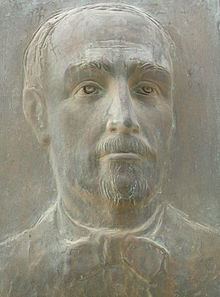Nationality Italian Known for Holy Land Architect Religion Catholic Role Architect | Occupation Franciscan monk Salary none Name Antonio Barluzzi | |
 | ||
Structures Church of All Nations, Dominus Flevit Church, Church of the Visitation, Church of the Transfiguration, Church of the Beatitudes | ||
Antonio Barluzzi: The architect who celebrates the mysteries of the life of Christ
Antonio Barluzzi (26 September 1884 – 14 December 1960) was an Italian Franciscan monk and architect. He became known as the "Architect of the Holy Land" by creating, among many others, the pilgrimage churches at the Garden of Gethsemane, on Mount Tabor (considered to be the Mount of Transfiguration), on the Mount of Beatitudes (the site of the Sermon on the Mount), and at the tomb of Lazarus. He also restored, giving them a new outlook, several churches and chapels including the Catholic chapel on Calvary, within the Church of the Holy Sepulchre.
Contents
- Antonio Barluzzi The architect who celebrates the mysteries of the life of Christ
- Antonio Barluzzi larchitecte qui clbre les mystres de la vie du Christ
- Biography
- World War I
- World War II
- Death and legacy
- Awards and honors
- Works
- References
Antonio Barluzzi: l'architecte qui célèbre les mystères de la vie du Christ
Biography
Barluzzi was born in Rome, the thirteenth child of Camillo Barluzzi and Maria Anna Busiri-Vici; his maternal grandfather Andrea Busiri-Vici was the architect responsible for the maintenance of St. Peter's Basilica. As early as five years old Barluzzi would create remarkable sketches of churches. His family lived close to the Vatican and historically were workers there. Barluzzi attended the Liceo Umberto I di Roma, where he was instructed by Giulio Salvadori. After leaving school in 1902, he began to pursue his calling, however he was persuaded to delay his entry into the priesthood only on the advice of his advisor and confessor Father Corrado, who wanted Barluzzi to further his education first. From 1902 until 1907 he attended the Sapienza University of Rome, successfully attaining a degree in Engineering. Barluzzi spent several years working with his brother, Giulio, on building projects in the Middle East. He was unsure whether to enter the priesthood and whilst discerning his vocation worked in Jerusalem on a 100-bed hospital for the Italian Missionary Society. While in Jerusalem he was asked by Father Razzoli, head of the Franciscan Custody of the Holy Land, to submit plans for a basilica on Mount Tabor.
World War I
With the outbreak of World War I in 1914 he was obliged to return to Italy. There, in 1915, on the recommendation of his confessors he joined the Seminario Romano di S. Giovanni on the Sunday after Easter. However he never attended any lectures and left after only a few weeks. After leaving seminary he joined the Italian army as a Sergeant and began his military service with the Fortifications Office overseeing archaeological excavations at the second-century Castel Sant'Angelo. In 1918 he joined the Palestine detachment and took part in the allied entry into Jerusalem.
While in Palestine he met Father Custos Ferdinando Diotallevi, the new head of the Custody of the Holy Land, who had the plans Barluzzi had previously drawn for Mount Tabor during his first visit. He requested Barluzzi start work simultaneously on this and another church at Gethsemane. Worried by this new responsibility Barluzzi returned to Italy to take advice, but ultimately returned to Jerusalem decided and determined. By 1924 he had completed The Church of All Nations at Gethsemane and the Church of the Transfiguration on Mount Tabor.
World War II
During the Second World War Barluzzi was in Sardinia doing building works for the Franciscan and Capuchin fathers. He remained in Italy until 1947. During this time he planned a great temple at the Holy Sepulchre and what he thought was his final work in the holy land, a Shrine to the Incarnation in Nazareth.
Death and legacy
Barluzzi died on 14 December 1960 in a small room at the Delegation of the Holy Land in Rome. His funeral was celebrated at the Basilica di Sant'Antonio and was attended by Cardinal Gustavo Testa, the procurator General of the Franciscan Order. There is a likeness of him near his church on Mount Tabor (pictured) and oddly he also appears in a fresco on the wall of the church he designed at Ein Karem. Barluzzi himself never wore his medals or spoke of his awards and was a simple monk in his behaviour whenever possible. Of his designs, the architecture writer H.V. Morton wrote "They are remarkable for their originality and the variety of their design... Barluzzi will be recognised as a genius in years to come."
